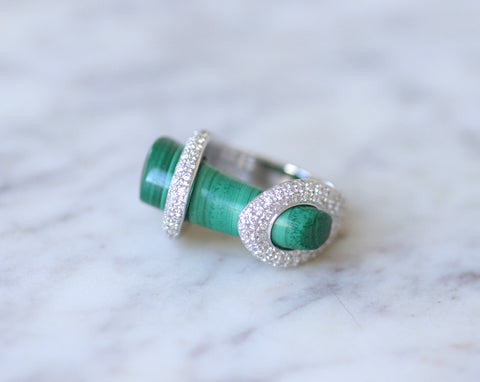
Maurice Denis, Palette de verts, 1921, Paris, Musée d'Orsay [preserved in the Louvre].
Implicitly associated with nature since the 19th century, green is nowadays regaining its credentials in parallel with urbanisation. "Green classes", "green spaces", the ecologist party, the pharmacy cross; examples of green as an allegory of nature are legion. But how can our contemporary era manage to restore the image of such a reviled colour? And why was green so disliked in our Western societies?

Gucci Cocktail ring, malachite and diamonds
Throw your what
The turbulent nature of colour is probably partly due to its chemical characteristics, since natural pigments, which were difficult to stabilise, faded rapidly in light, while the first artificial colours were corrosive. Napoleon knows something about this: it seems that in exile on St. Helena, he lived in rooms decorated with green. Scientific analyses carried out in the 1960s revealed large quantities of arsenic in the hair and under the fingernails of the deposed Emperor. Poisoning? Yes, but slow and insidious and through furniture! The poison would have been released by the humid climate of the island.

Emerald and diamonds Art Deco ring
Our unstable green becomes the colour of instability: that of fate, of destiny, of play - aren't game tables, sports fields (hard tennis courts, ping-pong tables) green? If the colour remains ambivalent, it is the negative dimension that has long prevailed: evil spirits, green poison, diabolical bestiary, "little green men" of Mars, "green with jealousy" (another reference to Angèle), and finally the legend tells that Molière died on stage in a green suit. And have you ever seen an actor dressed in green? Not everyone is Dalida.
Forgetting everything
However, green also has a calming effect (Goethe said so). It is also the colour of fertility, hope, luck, youth and health.
As a complement to red in the chromatic circle, green becomes the colour of permissiveness as opposed to the colour of prohibition. In fact, from the beginning of the 19th century, an international signage system was invented for boats, which was later used for trains and cars and continues to this day. Today, green symbolises free travel (nature and green numbers) and freedom - we "give the green light", and what foreigner doesn't dream of his or her "green card"? About time!

Art Deco jade and diamond disc pendant
Heavens, my jewels!

SPOILER ALERT if you haven't read The Adventures of Tintin - The Castafiore Jewels
Now that the colour green no longer holds any secrets for you - and we hope to have convinced the most sceptical - here is a list of the most commonly used green stones in jewellery: amazonite, chrysoberyl, emerald, jade, malachite, peridot.

Marquise emeralds and diamonds ring
There are so many shades that it's impossible not to find something that suits you! So, why not announce the colour?
Find our complete selection of green jewellery in the drop-down menu on the right.

